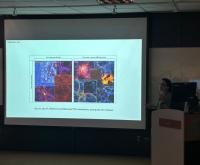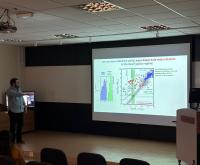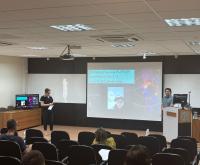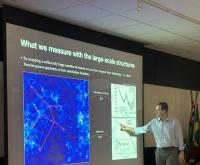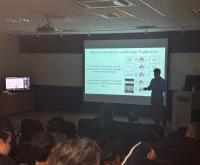SEMINÁRIO DO DEPARTAMENTO DE ASTRONOMIA
Galactic and cosmic chemical enrichment in the era of JWST
a talk by Prof. Chiaki Kobayashi (University of Hertfordshire) - In-Person
Abstract:
Stars are fossils that retain the history of their host galaxies. Carbon and heavier elements are created inside stars and are ejected when they die. Iron-peak elements are further produced by Type Ia supernovae. Elements heavier than iron (such as gold) can also be produced by neutron star mergers, but they alone cannot explain the observed "r-process" elements in the Milky Way. From the spatial distribution of these elements in galaxies, it is therefore possible to constrain star formation and chemical enrichment histories of the galaxies. This approach, Galactic Archaeology, has been popularly used for our Milky Way Galaxy with a vast amount of data from Gaia and multi-object spectrographs. We have been running cosmological chemodynamical simulations of galaxies including all chemical enrichment sources to follow the evolution of all elements. In the Milky-Way type galaxies, most of the bulge stars form at redshift z>2, while think disk stars form over several Gyrs. In the solar neighborhood, there are two distinct populations with or without rapid enrichment from Type Ia supernovae, which results in the bimodality of so-called alpha-to-iron ratios. Similar bimodal or trimodal distributions are seen for the other elements in our simulations. We also expect to see a similar alpha/Fe bimodality in other disk galaxies, and I will show recent observational results for the Andromeda Galaxy M31. This archaeological approach can also be applied to external galaxies, and the Jame Webb Space Telescope allows us to estimate elemental abundances of galaxies across Cosmic time, such as the nitrogen enhancement of GN-z11 at z=10.6. I will show observed O/Ar ratios, equivalent to alpha/Fe ratios, of high-redshift galaxies, and give some interpretations and future prospects.
Short-Bio:
Chiaki Kobayashi is recognized as the international leader in galactic chemical evolution. Soon after the PhD from University of Tokyo in 2002, she worked at Max-Planck Institute for astrophysics in Munich, National Observatory in Japan, and then became the Stromlo fellow at the Australian national University in 2008. She moved to the UK in 2011 to take up a faculty position at University of Hertfordshire, where she is a professor of astrophysics since 2021. Her recent work in linking the present-day Milky Way to the high-redshift universe, and she was awarded for 2024 George Darwin Lectureship from the Royal Astronomical Society.
Google Meet: https://meet.google.com/pcw-gmem-jyi
Link da transmissão: https://www.youtube.com/c/AstronomiaIAGUSP/live




